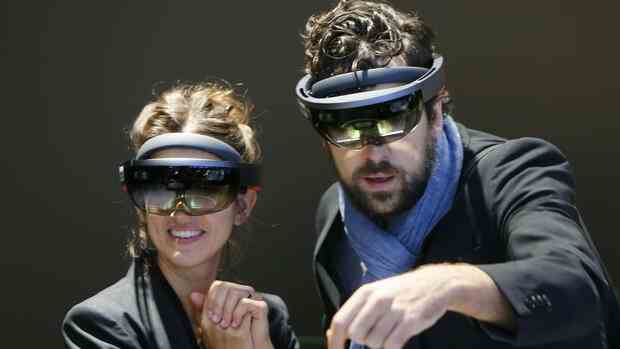Seattle The data glasses should actually open up a new world for Microsoft. CEO Satya Nadella invested billions in the area. As early as 2019, the technology group presented the Hololens 2, data glasses for industrial customers, and thus shaped the area. Many DAX companies also rely on Microsoft data glasses. The euphoria is now gone. Technologically, the glasses are outdated and many competitors have technically passed them by. The future of HoloLens at Microsoft seems unclear.
Because Nadella is changing course. The group recently announced that it would lay off 10,000 employees. According to media reports, the team behind the HoloLens should be severely affected. In addition, a few weeks ago, the US Congress stopped the purchase of further Hololens devices for the US armed forces, citing significant quality defects.
Instead Nadella has revised its strategy: artificial intelligence is now the focus. The Bing search engine is being expanded to include AI functions. Microsoft is thus challenging Google. Nadella wants to invest billions in the partnership with the AI start-up OpenAI.
With the focus on artificial intelligence, Microsoft also seems to be saying goodbye to its claim to leadership in the metaverse. Ironically, Microsoft leaves the field to its former rival Meta. Nadella was a guest speaker at a conference held by Meta boss Mark Zuckerberg in October. Microsoft programs such as Word or Teams should be integrated into the virtual worlds of Meta.
Hololens is now obsolete
But lately the setbacks have been piling up: Alex Kipman, the leading developer behind the Hololens, recently left the company because he had been accused of sexualized assaults in the workplace.
The Microsoft manager responsible, Robin Seiler, recently emphasized that the group would continue to rely on data glasses. “We continue to produce and support the Hololens 2,” said Seiler in a blog post. However, the manager did not reveal whether Microsoft will release a revised version of the device. The HoloLens costs between $3500 and $5199.
In terms of performance data, many competitors have long since passed Microsoft’s data glasses. Technology has evolved. However, the device from Microsoft is largely the same as it was three years ago.
Competitors take advantage of this situation. The start-up Magic Leap recently presented its first data glasses optimized for industrial customers. The glasses with the name Magic Leap 2 are characterized by a larger field of vision, a higher resolution and a significantly lower weight and cost 3299 dollars. Unlike the Hololens 2, the Magic Leap 2 is powered by a small computer that is usually worn on the pants. This makes it significantly lighter, but always connected to the computer by cable.
Magic Leap board member Daniel Diez told the Handelsblatt: “We have the necessary permits so that our glasses can now also be used in the operating room in the hospital.” Automobile companies could design models with the glasses, architects could design rooms or specialists could maintain complex machines.
We have the necessary approvals so that our glasses can now also be used in the operating room in the hospital. Magic Leap CEO Daniel Diez
The HoloLens 2 is no longer up to date. “Our device is clearly superior,” said Diez. Magic Leap can help ensure that VR glasses are used continuously in companies.
Meta is also planning new data glasses
This is exactly what the Facebook group Meta is planning. Parallel to the announcement of the partnership with Microsoft, Mark Zuckerberg presented new data glasses for the first time, which are aimed directly at corporate customers: the Meta Quest Pro with a price of 1799.99 euros in Germany.
Unlike the Hololens 2 or the Magic Leap 2, however, the Meta device’s surroundings are only dimly recognizable. But users can immerse themselves completely in a virtual world. Experts distinguish between VR glasses, in which users only look at small screens, and AR glasses, in which users see the environment and this is supplemented with additional information.
>> Read about this: Inside Microsoft: How Satya Nadella wants to make the company the most valuable company in the world again
Diez was convinced that VR glasses are not ideal for industrial use. In the operating room or in the factory, specialists should still be able to see their surroundings very well. Data glasses become useful when they can add useful information to the environment, such as information about which screw needs to be tightened in a complex machine to get it running again after a defect.
But despite numerous new devices, AR glasses are still not really suitable for the mass market, according to analyst Jitesh Ubrani from market researcher IDC. “The earliest time for such products would be late 2024 or early 2025,” Ubrani said. For him, the iPhone group Apple could make the difference.
Apple could launch its first data glasses later this year. The device will be presented at the WWDC developer conference, the Bloomberg news agency reported, citing insiders. The first version is VR glasses, later AR glasses are planned and finally maybe even contact lenses that can display digital information, Bloomberg reported. But that could take until the end of the decade.
More: The Microsoft group is working on these future technologies.
